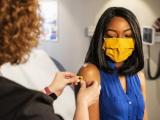May 1, 2009 (CIDRAP News) – National and international health authorities said today that they have begun the first steps in manufacturing a vaccine against the novel H1N1 swine influenza, though they appeared to disagree over whether full-scale manufacturing will move forward.
But flu-vaccine experts in several countries warned that major manufacturing and regulatory hurdles lie in the path toward achieving a pandemic vaccine, hurdles that have been recognized by governments for years but never successfully dealt with.
There is agreement on one point: The current seasonal flu vaccine will not protect against the novel virus. If authorities decide that a swine-flu vaccine is necessary, a new one will have to be formulated.
"There is very little chance that the seasonal vaccine as used in the vast majority of countries in the world would be effective against this particular virus," Dr. Marie-Paule Kieny, director of the World Health Organization's Initiative for Vaccine Research, said in a briefing today in Geneva.
This year's seasonal vaccine formula will be administered soon in the southern hemisphere and currently is being manufactured for the northern hemisphere. Some manufacturers have grown all the vaccine virus needed for their production run, have moved the result to bulk storage for later packaging, and therefore could be ready to start a limited-production test of the new virus if necessary. But others are not done: According to the Centers for Disease Control and Prevention, some manufacturers have had difficulty growing one of the three major seasonal vaccine components, a strain that induces immunity to the family of viruses known as influenza B.
That lag raises the possibility that manufacturers could be asked to short-circuit work on the seasonal vaccine in order to begin handling the seed strain of the novel virus, a move that would reduce the amount of vaccine available in the northern hemisphere next winter.
"Some of the manufacturers may be 60% through, some of the manufacturers may be a little bit less, and not the same level either for the three components," Kieny said. "We are in discussion with them to try to see at what moment it might be the best solution to stop the seasonal and to start the pandemic" formula.
An immutable timeline
WHO and CDC representatives said today that the timeline for producing even test lots of a swine-flu vaccine is immutable.
It begins with the CDC's Atlanta labs—the lead institution of the four international influenza collaborating centers—developing a "seed strain" of vaccine virus out of one of the isolates taken from the swine flu victims. That process, which takes 2 to 3 weeks, aims to develop a hybrid virus that retains the immune profile of the original virus but grows well in embryonated chicken eggs, which are the main growth medium used in flu-virus manufacturing. The result is then given to manufacturers to develop small pilot lots of vaccine for animal and human trials, a process that can take up to 11 weeks of production before any trials begin.
Rumors are circulating among some flu scientists that the strain being used at the CDC for the vaccine seed strain is not growing well in eggs. The WHO and CDC appeared to acknowledge this Friday, disclosing that they are preparing two seed strains for manufacturers: one that was naturally reassorted by allowing viruses to mix in eggs, and another tuned via a patented process called reverse genetics that cuts and pastes genes from the swine virus with a non-pathogenic virus in order to achieve the highest possible growth rate. Manufacturers will be allowed to choose, the agencies said.
At the moment, the naturally reassorted strains are being grown at the CDC and at New York Medical College, and the reverse-engineered strains are being worked on at the CDC and the other WHO collaborating centers along with the Food and Drug Administration. WHO convened an international meeting of manufacturers 2 days ago, and "several dozen" are prepared to receive strains, Kieny said.
Vaccine yield is unpredictable
That production will go smoothly is not guaranteed: Since 2000, seasonal flu-vaccine delivery has been delayed several times because strains did not grow as well as predicted or eggs proved vulnerable to contamination. But if the swine-flu seed strains grow as well as hoped, by early autumn manufacturers and regulatory authorities will have to consider how to begin testing the pilot lots.
That is a key issue for safety: In the abortive 1976 swine-flu outbreak, the vaccine caused a paralysis (Guillain-Barre syndrome) that occurred approximately once in every 1 million doses given, a proportion that was not reflected in the trials conducted then. But it will also determine in what size doses the vaccine will be given, if it moves to full manufacture—and that is a critical issue because international capacity for making vaccine is limited.
The "standard dose" of antigen for flu vaccine is 15 micrograms (mcg) of flu-virus proteins. (Seasonal vaccines comprise three doses of 15 mcg—two from the influenza A family and one representing influenza B—in a single shot.) The larger the dose needed to produce immunity, the smaller the number of people who can be vaccinated if the formula moves to full production. Testing would also determine whether immunity could be achieved with one dose or would require two, a need that would effectively halve the number of shots available.
Current estimates of global capacity vary wildly. Rear Admiral Anne Schuchat, MD, interim deputy director of the CDC's Science and Public Health Program, told Congress Thursday that US manufacturing capacity would allow for the production of 600 million doses, or two shots for every US resident. Kieny said Friday the current global capacity is approximately 700 million doses. A report released in March by the International federation of Pharmaceutical Manufacturers and Associations puts current global capacity at 917 million doses—but it relies on assumptions that include an average dose of 9 micrograms, not 15.
Still dependent on eggs
Both the limitation on manufacturing capacity and the time it takes to produce doses are dictated by the dependence on chicken eggs, a technology that has been essentially unchanged for 50 years. Since concerns over avian flu H5N1 first sparked in 1997, numerous experts have warned that egg-based vaccines would leave the world exposed to vaccine shortfalls at a critical moment. Nevertheless, plants with faster, cleaner next generation-technology, cell culture, are not scheduled to come online in the United States for 2 more years.
"That is the real frustration, that we have been talking about this for 12, 13 years and have not yet found the will to do this better and faster," said Dr. Gregory Poland, director of the Mayo Clinic's Vaccine Research Group. "And here we are in a global emergency, at phase 5 of 6. What does it take?"
The WHO and CDC seemed to disagree Friday over whether manufacture of a vaccine would move ahead, with the CDC's Dr. Nancy Cox, director of the influenza division, saying that discussions are under way, and Kieny saying, "It seems most likely we will proceed."
If pilot lots pass clinical trials and move to full manufacture—a process that would take several more months—another significant hurdle remains: how to get the vaccine past government regulators.
A monovalent vaccine (one containing only one strain) could be presented to the FDA under existing licenses, said Dr. David Fedson, a former vaccine-industry researcher and longtime critic of pandemic preparations—but authorities would then have to rely on citizens to return for one or two shots in addition to the standard seasonal vaccine. Combining the new vaccine with the existing vaccine into a quadrivalent (four-strain) product, while potentially more acceptable to consumers, would face far more regulatory hurdles because it would represent a new formulation—and, if it were contaminated or held up by manufacturing problems, could imperil potentially the entire seasonal vaccine supply.
The issue of manufacturing capacity, and possibly also of immunogenicity, could be solved at a stroke if a new vaccine were to include an adjuvant, effectively an immune-system activator that allows doses to be diluted and thus makes many more shots available. Pandemic planners have pushed for adjuvant licensure in the United States for years; they were first called for after the 1957 pandemic. But so far, only one adjuvant has been licensed in the United States, and regulators have said that in order to be approved, any adjuvanted vaccine must be tested using the exact adjuvant-antigen dosage that will be marketed—thus requiring an additional layer of testing that is unlikely to fit the need for speed in achieving a pandemic vaccine.
See also:
CDC press briefing transcript
http://www.cdc.gov/media/transcripts/2009/t090501.htm
















